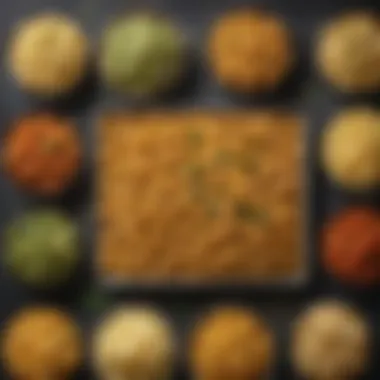Pasta in Vegan Diets: A Culinary Exploration


Intro
In a world where culinary choices are becoming increasingly diverse, the intersection of veganism and pasta serves as a fascinating topic of exploration. Pasta, a staple in many cultures, often comes with an array of ingredients that traditionally may not align with a vegan lifestyle. However, understanding the various components of pasta and its adaptability can unveil numerous possibilities for those adhering to vegan diets.
This narrative aims to delve into not only the types of pasta suitable for vegans but also the nutritional aspect and practical adaptations that can make pasta an easy and delightful centerpiece in vegan meals. As we navigate through this guide, we aim to elucidate common misconceptions surrounding vegan pasta dishes while offering practical recipes and tips to accommodate both busy lifestyles and unique culinary desires.
Through this exploration, we seek to highlight how pasta can be integrated seamlessly into the vegan diet, creating satisfying and health-conscious meals. Let's embark on this journey to better understand pasta's role in a vegan lifestyle and how it can be a delicious option for everyone.
Understanding Veganism
Understanding veganism is foundational to examining how pasta consumption can fit within this dietary framework. It's not merely about abstaining from animal products but also encompasses a broader ethic of promoting sustainability, ethical treatment of animals, and often, a commitment to health. In the context of pasta, which is a staple food enjoyed globally, understanding the principles of veganism allows us to differentiate between traditional pasta that may contain eggs and alternatives that cater to vegan diets. This distinction is crucial not just for culinary enthusiasts but also for anyone who may be considering a plant-based diet for ethical or health-related reasons.
Definition of a Vegan Diet
A vegan diet eliminates all animal-based products, including meat, dairy, eggs, and sometimes honey. Instead, it relies on plant-derived foods. This type of diet is often rich in fruits, vegetables, legumes, nuts, seeds, and whole grains. For pasta lovers, the key takeaway is that a vegan diet does not compromise on flavor or diversity; rather, it opens avenues for more plant-based ingredients, allowing for creative twists on traditional dishes.
Common Reasons for Choosing Veganism
Many individuals choose veganism for a variety of reasons that can range from ethical to environmental and health considerations:
- Ethical Reasons: Concerns about animal welfare propel many towards a vegan lifestyle. People want to avoid contributing to the cruelty often associated with animal farming.
- Environmental Concerns: Studies show that animal agriculture significantly impacts global warming, deforestation, and water scarcity. By adopting a vegan diet, one can reduce their carbon footprint.
- Health Benefits: Some may turn to veganism to improve health, citing benefits like weight loss, lowered cholesterol, and reduced risk of chronic diseases. This broad category of motivations plays a significant role in the acceptance of plant-based alternatives, including pasta.
Nutritional Considerations
When adopting a vegan diet, it is vital to ensure nutritional adequacy. Pasta is primarily a source of carbohydrates, but it's essential to balance it with proteins and micronutrients found in vegetables, legumes, and nuts. For example, while regular wheat pasta provides energy, incorporating lentil or chickpea pasta can boost protein intake.
Nutritional diversity is key in a vegan diet; blending various sources can prevent deficiencies and promote overall health.
Moreover, attention to essential nutrients like Vitamin B12, iron, and calcium is crucial. Deficiencies can arise without careful meal planning, particularly when shifting from an omnivorous diet. Understanding these aspects of veganism is vital as it sets the stage for effectively integrating pasta into a nourishing, plant-based lifestyle.
Pasta: A Culinary Staple
Pasta is more than just a meal; it's a cultural icon and a trusty comfort food that has wormed its way into kitchens around the globe. For those exploring vegan diets, understanding pasta's role and its adaptability is crucial. With its roots strongly planted in Italian cuisine, pasta comes in myriad shapes, sizes, and formulations. This versatility makes it a prime candidate for integration into various diets, including veganism.
In the realm of vegan dietary frameworks, pasta can be a nutritious and satisfying option when approached correctly. The right choices can maximize flavor while keeping dishes plant-based, aligning with the nutritional requirements of a healthy vegan lifestyle. Moreover, pasta serves as a blank canvas, ready to absorb flavors from sauces, spices, and vegetables, making it a favorite among culinary enthusiasts.
Types of Pasta
When delving into the types of pasta, it’s important to recognize the variety that exists beyond the traditional offerings. Classic varieties such as spaghetti, penne, and fusilli are often the first to come to mind, but there are countless others worth exploring. Each shape has its purpose, interacting with sauces and ingredients in unique ways.
- Fresh Pasta: Often made with flour and water, sometimes eggs, although plant-based versions exist. Fresh pasta offers a tender texture and can be molded into a favorite shape.
- Dried Pasta: More common in pantries, it is usually made from durum wheat semolina and water. Dried pasta generally holds up better in cooking.
- Whole Wheat Pasta: A healthier alternative that retains more fiber and nutrients. It has a nuttier flavor that some appreciate more.
- Gluten-Free Pasta: Made from rice, corn, or other gluten-free grains, this option caters to those with gluten intolerances while providing a similar texture.
- Legume-Based Pasta: This newer twist offers protein-rich alternatives made from lentils or chickpeas, catering well to both health-conscious eaters and vegans.
Traditional Ingredients in Pasta
Exploring traditional pasta ingredients might reveal some pitfalls for vegan consumers. Typically, pasta is made from flour and water, making many varieties suitable for a vegan diet. However, several types contain eggs, particularly fresh pasta. This is where label-reading becomes vital. Look for ingredients clearly marked as vegan.
"The simplest pasta is a concoction of two ingredients: flour and water. But, beware of the ones sneaking in egg!"
In addition, the garnishes and sauces served alongside pasta can conflict with a vegan lifestyle. Classic pasta dishes often incorporate cheese, cream, and meat-based sauces. Understanding these traditional constituents is central to adapting these beloved recipes into fully plant-based versions.
Cooking Methods for Pasta
Cooking pasta might seem straightforward—boil, stir, and serve—but there’s a bit more to it for those looking to create a perfect dish. Here are some considerations that elevate the cooking experience, especially when focusing on enhancing a vegan diet:


- Boiling: Always start with a large pot of well-salted water. This enhances flavor right from the get-go. Al dente is the desired texture; it offers a slight bite with each mouthful.
- Sautéing: A method often missed is sautéing garlic and vegetables in olive oil before adding the cooked pasta. This step infuses each bite with rich flavors that can elevate even the simplest dish.
- Baking: Some recipes benefit from a baked twist, merging pasta with vegetables and a vegan cheese to create a comforting casserole.
- Chilling: Pasta salads made with chickpea or lentil pasta can be a refreshing meal. Toss with fresh herbs, veggies, and a zesty dressing for a light dish.
Navigating the world of pasta may at first seem daunting for a vegan diet. Yet, with the right knowledge, choices, and methods, it can transform from merely a comfort food into a versatile staple that satisfies cravings while adhering to dietary principles.
The Vegan Perspective on Pasta
Understanding veganism and its principles is crucial when considering staple foods like pasta. Focusing on pasta from a vegan perspective entails looking at the ingredients, accessibility, and culinary creativity. Pasta is often viewed as a comfort food, and for many, it is a daily meal. However, how does one balance the joy of pasta with a vegan philosophy?
Evaluating Traditional Pasta Ingredients
When we think of traditional pasta, we often picture the classic white and egg noodles. Eggs are commonly used in many pasta varieties, particularly those from Italy, like tagliatelle or fettuccine. As such, they remain a sticking point for many who choose a vegan diet. Beyond eggs, typical pasta ingredients, such as flour and water, pose little to no issue for vegans. The challenge comes from understanding what comprises store-bought pasta. Many prepared varieties include added preservatives, artificial colors, and sometimes dairy.
To critically assess pasta, it’s helpful to read labels closely. Those looking for plant-based options should be on the lookout for pasta marked as egg-free and vegan. Many brands today proudly state their vegan credentials.
Identifying Vegan-Friendly Pasta Options
The good news is that the vegan-friendly pasta market is expanding rapidly. Many companies are now creating pasta that is both delicious and entirely plant-based. Common options include:
- Whole wheat pasta: Made from durum wheat, it contains no eggs and offers a nuttier flavor and higher nutritional value.
- Gluten-free pasta: Often crafted from rice or corn, this type caters to those with gluten sensitivities while also being vegan.
- Legume-based pasta: A recent trend involves pastas made from chickpeas, lentils, or black beans. These not only meet vegan standards but pack a nutritional punch.
Some popular brands that offer extensive vegan pasta lines include Banza, Explore Cuisine, and Tolerant, each providing unique flavors and textures to enrich a vegan meal plan.
Plant-Based Alternatives to Traditional Pasta
If you’re after something outside the flour-water tradition, options abound. Innovative alternatives have emerged, each more intriguing than the last. Here are a few noteworthy choices:
- Zoodles: That’s right, zucchini noodles! Using a spiralizer, fresh zucchinis transform into a low-carb alternative, providing a refreshing twist to traditional dishes.
- Spaghetti squash: When cooked, the flesh of this squash separates into strands resembling spaghetti. It’s low in calories and packed with vitamins.
- Shirataki noodles: Made from konjac yam, these noodles are virtually calorie-free, making them a popular choice for those seeking lighter fare.
"The beauty of pasta lies not just in its form, but in the way it can be adapted to nourish all diet preferences."
Not only do these plant-based alternatives cater to vegan needs, but they also introduce various flavors and textures. Whether one opts for classic pasta or ventures into alternative territory, it's about finding what fits best within the culinary ethos of a vegan diet.
Nutritional Insights of Vegan Pasta
Understanding the nutritional benefits and considerations of vegan pasta is essential for anyone looking to integrate it meaningfully into their diet. This segment will shed light on specific nutritional components, address the health benefits associated with pasta made from plant-based ingredients, and provide insights into how these fit into a balanced vegan diet. We're unpacking more than just carbs here; think of it as a roadmap to healthier choices.
Protein Sources in Vegan Pasta
When it comes to protein in vegan pasta, options are more diverse than one might think. Traditional wheat pasta generally has a lower protein content compared to its legume-based counterparts. For instance, chickpea pasta often shines in this department, boasting a robust protein profile that can help vegans meet their daily requirements.
- Lentil pasta is another rising star, providing high protein and fiber, making it really filling.
- Quinoa pasta not only offers a unique taste but also supplies the complete protein your body needs, since it contains all nine essential amino acids.
For those wanting to take it up a notch, mixing beans or lentils into your pasta dishes can further amplify protein levels. It’s a simple yet mighty way to ensure you're fueling your body with adequate nutrition. Remember, protein isn't just a number; it plays a key role in muscle health, immune function, and overall well-being.
Carbohydrate Content and Vegan Diets
Carbohydrates are often brushed off in vegan discussions, yet they are crucial for energy, especially for active individuals. Most vegan pasta options, such as those made from whole grains, provide complex carbs that digest slowly, helping maintain steady energy.
- Whole wheat pasta, for instance, is rich in fiber, which is beneficial for digestion and satiety.
- On the flip side, some gluten-free varieties made from corn or rice might not pack as much fiber, so it's about striking the right balance.
By including a variety of pasta types in your diet, you can enjoy complex carbs, while steering clear of processed foods that might spike blood sugar levels. Keeping an eye on portion sizes and the accompanying sauces is wise, as they can sometimes tip the balance.
Essential Nutrients and Vegan Pasta Dishes


In any vegan diet, ensuring you're getting all essential nutrients is vital. Here’s where the beauty of a well-crafted vegan pasta dish really shines. By incorporating thoughtfully chosen ingredients, vegan pasta can be a treasure trove of nutrition.
- Vitamins and minerals: Adding vibrant vegetables—think spinach, bell peppers, or carrots—to your pasta can ramp up the dish’s vitamins A and C, as well as iron and calcium.
- Healthy fats: Toss in some olive oil or avocado for those heart-healthy fats that promote cardiovascular health.
- Fiber: As mentioned earlier, legume-based and whole grain pastas are much higher in fiber, aiding in digestive health and maintaining a healthy weight.
"A well-rounded vegan pasta dish is not just about filling your stomach; it’s about feeding your body the nutrients it needs to thrive."
Each bite can become a part of a comprehensive dietary strategy that nourishes not just the body but also supports overall health. And at the end of the day, it’s all about finding satisfaction in what you eat while prioritizing well-being.
Practical Tips for Vegans Cooking Pasta
Cooking pasta can be a simple yet delightful experience, especially for those adhering to a vegan lifestyle. In a world filled with choices, practical tips can help streamline the process and elevate the culinary experience. Knowing how to navigate the pasta landscape makes all the difference in avoiding pitfalls that may arise from ingredient misunderstandings or time constraints. This section offers essential advice tailored for vegans to ensure they can enjoy this beloved dish fully while maintaining their dietary choices.
Selecting the Right Pasta
When it comes to choosing pasta, the label can be your best friend. Many pasta brands now offer options that cater directly to vegan diets, which take the guesswork out of the equation. Look for pasta made from whole grains like brown rice, quinoa, or lentils, as these often provide more protein and nutrients than traditional wheat pasta.
- Check Ingredients: Always read the label. Some lesser-known pasta types, like egg noodles or certain fresh pastas, contain non-vegan ingredients.
- Consider Gluten-Free: If gluten is a concern, there are numerous gluten-free varieties available, made from alternatives like chickpeas or rice.
- Whole Grain vs. Refined: Prioritize whole grain pasta for added fiber and a lower glycemic index, which can help mitigate blood sugar spikes.
It's worth noting that the shape and size of pasta can impact the final dish. Tubular shapes hold sauces better, while flat shapes lend themselves well to oil-based companion dishes.
Sauces and Pairings for Vegan Pasta
What is pasta without a heavenly sauce to accompany it? Opting for vegan sauces not only enhances flavor but also contributes nutritional value. It’s all about balancing flavors, textures, and nutrition.
- Tomato-Based Sauces: A classic marinara or arrabbiata can be easily enhanced with fresh herbs, garlic, and vegetables.
- Creamy Vegan Options: Cream sauces can be mimicked using blended cashews, almond milk, or even silken tofu. These alternatives provide a rich texture while adding protein.
- Pesto: Swap out traditional cheese with nutritional yeast or almond meal for a vegan pesto that bursts with flavor.
Pairing is where creativity truly shines. Consider adding seasonal vegetables like zucchini, bell peppers, or spinach to your pasta dishes to impart more nutrients and color. Additionally, toasted pine nuts or sunflower seeds can add a delightful crunch when sprinkled atop your meal.
Time-Efficient Cooking Techniques
In today's fast-paced world, saving time in the kitchen is paramount. Employing efficient cooking techniques can mean the difference between a hurried meal and a thoughtful dining experience.
- Batch Cooking: Prepare big batches of pasta to keep on hand for quick meals throughout the week. Store it in the fridge and reheat with disparate sauces.
- One-Pot Dishes: Consider one-pot pasta recipes where everything cooks together. This method not only saves time but also ensures all the flavors meld perfectly.
- Prepping Ingredients: Chop your veggies and measure out sauces ahead of time. Having an organized workspace makes for a smoother cooking experience.
- Use the Right Temperature: Avoid overcooking pasta by ensuring your water is at a rolling boil before adding it. This method helps retain the pasta's texture, so it doesn't end up mushy.
Utilizing these time-saving techniques not only allows you to enjoy pasta but frees up time in your day for other invigorating pursuits.
"Cooking is an art, but it doesn’t have to be complicated. With careful selection and smart techniques, vegan pasta can be extraordinary yet straightforward."
In summary, a thoughtful approach to selecting pasta, complementing it with suitable sauces and pairings, coupled with efficient cooking methods, fosters an environment where vegan diets can be both delicious and accessible. Embracing these tips not only enhances the culinary journey but also supports a sustainable and healthy lifestyle.
Sample Vegan Pasta Recipes
In this section, we explore various vegan pasta recipes that not only highlight the flexibility of pasta but also cater to the dietary preferences of a plant-based lifestyle. Using simple and wholesome ingredients, these dishes can easily become staples in the kitchen. The benefits of these recipes include quick preparation times, nutritional value, and their potential to impress both vegans and non-vegans alike. Here, we have three diverse recipes that together illustrate the wide-ranging possibilities of vegan pasta.
Quick Vegetable Pasta
A delicious Quick Vegetable Pasta serves as a delightful blend of seasonal produce and pasta. With a cooking time that rivals the speed of ramen noodles, this dish is perfect for those hectic weeknights. Simply boil your favorite pasta—be it penne or spaghetti—and while it's cooking, sauté a medley of vegetables. Think bell peppers, zucchini, and spinach tossed in olive oil with a sprinkle of garlic. This combination not only imbues the dish with a burst of color but also ensures a healthy platter, rich in vitamins.
To finish off, drain the pasta, mix it with the sautéed veggies, and top it all off with a generous drizzle of lemon juice and a splash of balsamic vinegar. The tangy punch complements the sweetness of the veggies, delivering a wholesome meal in no time. Not only is this easy to whip up, but it's also easy on the budget—a win-win in any cook's book!
Chickpea Pasta Salad
Chickpea Pasta Salad introduces a twist on traditional pasta salads, packing protein and fiber into every spoonful. Using chickpea pasta, which can often be found in most grocery stores nowadays, this recipe is particularly eye-catching. Start by cooking the chickpea pasta as per the package instructions, then allow it to cool.


Next, toss in a mix of chopped cucumbers, cherry tomatoes, and red onions. For some added flavor, dress it with a simple blend of olive oil, lemon juice, and dried oregano. This dish not only has a refreshing taste but also provides a hefty dose of nutrients. Ideal for meal prepping, a serving of this salad can accompany you during busy weekdays, ensuring your meals don't lack in nutritional punch.
Creamy Avocado Pasta
Creamy Avocado Pasta might just change the way you perceive creamy sauces altogether. With ripe avocados as the star, this recipe is not just delicious but also quick to prepare. Boil your choice of pasta until al dente, then set it aside. In a blender, combine the flesh of ripe avocados, garlic, lemon juice, fresh basil, and a splash of water to create a silky smooth sauce. The result is a rich and creamy texture without the need for dairy.
Toss the cooked pasta in this lush sauce, and for extra texture, add roasted cherry tomatoes and pine nuts. Not only do these additions amplify the flavor profile, but they also provide a satisfying crunch, elevating the dish from mundane to extraordinary. Without a doubt, this recipe is perfect for impressing dinner guests who might still be stuck in the non-vegan mindset.
"Vegan pasta dishes not only cater to the plant-based lifestyle but also open up a world of flavors and textures that can be equally satisfying as traditional options."
Ending
Crafting these vegan pasta recipes welcomes a new array of flavors into one’s culinary repertoire. From vibrant vegetable pastas to protein-rich chickpea salads, and creamy avocado delights, vegan pasta can fit seamlessly into anyone's diet. Not just fast and easy, these meals reflect thoughtful eating, making them ideal for the discerning and health-conscious individual.
Challenges Faced by Vegan Pasta Eaters
Vegan diets have gained a lot of traction over the past few years, yet the journey of incorporating pasta can have its hiccups. It's crucial to recognize the hurdles that might surface during this culinary adventure. Many individuals may have heard pasta is universally safe for vegans, but that's far from the truth. Often, the devil is in the details, and that’s why understanding these challenges provides better navigation through pasta consumption within a vegan framework.
Misconceptions About Vegan Pasta
Many tend to believe that all pasta is vegan, assuming it's solely made from wheat and water. This is a common misconception. While the majority of dry pasta indeed fits that bill, several varieties contain eggs or dairy, primarily those in specialty or fresh pasta like tagliatelle or ravioli. This can lead to confusion when scanning labels in a grocery store or perusing a menu at an Italian restaurant.
A deeper understanding can debunk these myths. For instance, certain popular brands like Barilla or De Cecco offer egg-free versions, but many artisan brands do not. It’s always a smart move to look for labels that explicitly mark products as vegan. Even seemingly innocent additions, like sauces or toppings, may contain non-vegan ingredients. To address this, one could always opt for whole-grain or legume-based pasta varieties, which are naturally vegan and may offer additional nutritional benefits.
Accessibility of Vegan Pasta Options
When stepping out into a world where pasta meets veganism, one might encounter a baffling maze of options and accessibility issues. Supermarkets vary widely in their vegan pasta inventory. In larger urban areas, dedicated health food stores may have aisles brimming with exciting pasta alternatives made from lentils, chickpeas, or brown rice, but smaller towns might not have those luxuries.
Dining out poses challenges as well, with some restaurants surprisingly inadequate in offering vegan-friendly options. Not all establishments make it clear which dishes are suitable for vegans, and the limited selection can be disheartening. Furthermore, if a pasta dish doesn’t explicitly state veganism, it’s often safest to ask the server or chef directly. Those unfamiliar with culinary terms might not think to inquire, leading to potential dietary mishaps. As a result, it is beneficial to be proactive—perusing menus online ahead of time or, if necessary, picking a restaurant that openly caters to vegan clientele can make all the difference.
Navigating Dining Out as a Vegan
Venturing into restaurants, especially Italian ones, should be pleasing, but the reality sometimes falls short. Vegan diners face the daunting task of transforming complex menus into a list of possibilities that align with their dietary preferences. While some flagship Italian chains have begun to cater to dietary restrictions, many local mom-and-pop spots might not understand what vegan means, leading to awkward dinner conversations.
To avoid being caught in a culinary pickle, arriving equipped with questions is key. Asking if pasta is made with eggs or if a sauce includes cream can save you from a potentially disappointing meal. Additionally, many dining establishments are willing to adapt their dishes; being polite and clear about one’s needs can lead to delightful surprises that are not always listed on the menu. It also pays off to explore local vegan or vegetarian restaurants, where pasta usually tends to be made sans animal products.
"Navigating the dining landscape as a vegan requires a mix of curiosity and caution, ensuring your love for pasta is unimpeded by unintentional slip-ups."
While challenges exist for vegan pasta lovers, staying informed and prepared can make for a smoother pasta experience in both home kitchens and restaurants alike.
Ending: Embracing Pasta in a Vegan Diet
In summing up the relationship between pasta and veganism, it's crucial to recognize how pasta has evolved as a versatile staple for those following a plant-based lifestyle. This article has delved into how pasta fits seamlessly within a vegan framework, not just as a meal option, but also as a platform for creativity in the kitchen. The interplay of various ingredients and cooking techniques opens up a myriad of combinations that cater to different tastes and dietary preferences.
The Versatility of Vegan Pasta
Vegan pasta isn't just a food - it’s a canvas for flavor and nutrition. The traditional stigma that pasta is a mere carb source has shifted dramatically. With the rise of legume-based options, whole grains, and vegetable-infused noodles, the culinary landscape is far broader than what it once was.
Consider these versatile choices:
- Chickpea Pasta: Rich in protein and fiber, this type not only brings health benefits but also a nutty flavor that complements many sauces.
- Zucchini Noodles: A perfect alternative for those reducing carbs, zoodles (zucchini + noodles) can easily soak up flavors from sauces while adding a fresh twist.
- Rice Noodles: Often used in Asian cuisines, these are gluten-free and can be incorporated into a variety of dishes, from stir-fries to salads.
By choosing vegan pasta, individuals can mix and match ingredients, ensuring a balanced intake of essential nutrients while keeping meals exciting and inventive. Cooking becomes less about restriction and more about exploration and adaptation.
Future Trends in Vegan Pasta Consumption
As society increasingly recognizes the benefits of a plant-based diet, the trend towards vegan pasta consumption seems poised for growth. Several key indicators suggest that innovation in this space is just beginning:
- Ingredient Innovation: Companies are emerging with new types of pasta made from diverse ingredients like lentils, black beans, and even peas, expanding the choices available to consumers.
- Health Awareness: People are becoming more conscious about their food choices, leading to a demand for healthier alternatives to traditional pasta. This trend is likely to push producers towards enhancing the nutritional profiles of their products.
- Sustainability Practices: With a focus on sustainable eating, the shift to plant-based diets is expected to further promote vegan pasta, as it has a lower environmental impact compared to animal-based foods.
To wrap it all up, embracing pasta within a vegan diet is not just sensible; it's transformative. As trends continue to shift towards plant-based eating and innovation flourishes within this category, pasta stands out as a nutritious and adaptable choice for culinary enthusiasts. The possibilities are only as limited as one's creativity.







